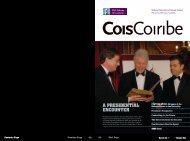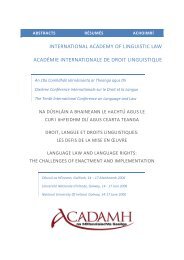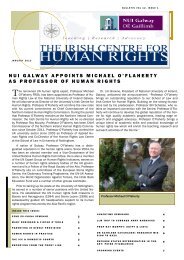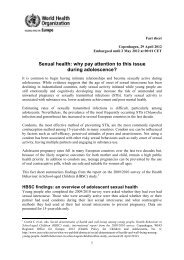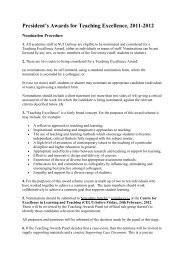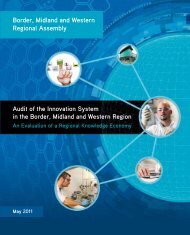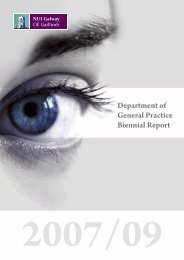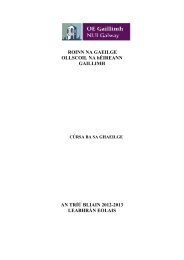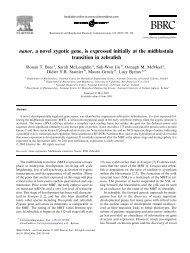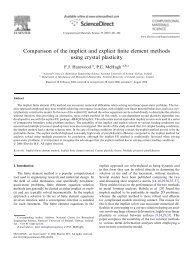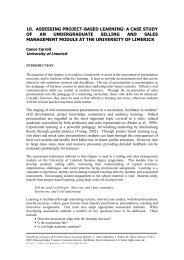HBSC Ireland: Workshop to access young people's opinions of the ...
HBSC Ireland: Workshop to access young people's opinions of the ...
HBSC Ireland: Workshop to access young people's opinions of the ...
You also want an ePaper? Increase the reach of your titles
YUMPU automatically turns print PDFs into web optimized ePapers that Google loves.
Short Report<br />
<strong>HBSC</strong> <strong>Ireland</strong>: <strong>Workshop</strong> <strong>to</strong> <strong>access</strong> <strong>young</strong> people’s <strong>opinions</strong> <strong>of</strong> <strong>the</strong> findings <strong>of</strong> <strong>the</strong><br />
2010 Health Behaviour <strong>of</strong> School-aged Children (<strong>HBSC</strong>) Survey.<br />
Natasha Clarke, Colette Kelly, Michal Molcho, Saoirse Nic Gabhainn.<br />
<strong>HBSC</strong> <strong>Ireland</strong>, Health Promotion Research Centre<br />
National University <strong>of</strong> <strong>Ireland</strong>, Galway<br />
2012
Introduction<br />
The Health Behaviour in School-aged Children (<strong>HBSC</strong>) study is a cross-national research study conducted in collaboration with <strong>the</strong> WHO<br />
Regional Office for Europe and runs on a 4 year cycle. In 2010 <strong>Ireland</strong> participated for <strong>the</strong> third time in <strong>the</strong> <strong>HBSC</strong> study with over 16,000<br />
schoolchildren in 256 schools across <strong>Ireland</strong> taking part; previous surveys were conducted in 2006, 2002 and 1998. <strong>HBSC</strong> <strong>Ireland</strong> is funded by<br />
<strong>the</strong> Department <strong>of</strong> Health.<br />
The overall aims <strong>of</strong> <strong>the</strong> <strong>HBSC</strong> study are <strong>to</strong> gain new insight in<strong>to</strong>, and increase our understanding <strong>of</strong> <strong>young</strong> people’s health and well-being,<br />
health behaviours and <strong>the</strong>ir social context. Young people are actively involved in providing data through completing questionnaires. However,<br />
<strong>the</strong>re is increasing recognition <strong>of</strong> <strong>the</strong> value <strong>of</strong> involving <strong>young</strong> people in various stages <strong>of</strong> <strong>the</strong> research process (Alderson, 2001; Sinclair, 2004).<br />
One <strong>of</strong> <strong>the</strong> key functions <strong>of</strong> <strong>the</strong> <strong>HBSC</strong> study is <strong>to</strong> inform policy and practice. Towards achieving this <strong>young</strong> people participated in a workshop<br />
before <strong>the</strong> launch <strong>of</strong> <strong>the</strong> <strong>HBSC</strong> National Report 2010. This workshop was one step in a planned series <strong>of</strong> steps designed <strong>to</strong> include <strong>young</strong><br />
people in <strong>HBSC</strong> <strong>Ireland</strong> and <strong>to</strong> give <strong>the</strong>m a voice in our research.<br />
Objectives<br />
The workshop aimed <strong>to</strong> <strong>access</strong> <strong>young</strong> people’s <strong>opinions</strong> <strong>of</strong> <strong>the</strong> findings <strong>of</strong> <strong>the</strong> 2010 Health Behaviour in School-aged Children Survey. There<br />
were three objectives; <strong>to</strong> enable <strong>the</strong> <strong>young</strong> people <strong>to</strong> identify what was <strong>the</strong> most interesting finding, what was <strong>the</strong> most surprising finding, and<br />
what <strong>the</strong> youth health priorities should be as a result <strong>of</strong> <strong>the</strong>se findings.<br />
Methodology<br />
Twenty-five students (13-15 years) in a mixed-gender post-primary school in <strong>the</strong> West <strong>of</strong> <strong>Ireland</strong> participated in this workshop. After <strong>the</strong><br />
researcher explained <strong>the</strong> project and <strong>the</strong> purpose <strong>of</strong> <strong>the</strong> session <strong>to</strong> <strong>the</strong> participants <strong>the</strong> workshop began. Each participant was given a copy <strong>of</strong><br />
<strong>the</strong> <strong>HBSC</strong> 2010 National report <strong>to</strong> examine and were asked <strong>to</strong> provide any feedback <strong>the</strong>y had on <strong>the</strong> report design, layout or content with <strong>the</strong><br />
group. Group discussion was facilitated and all comments were recorded. When this group discussion was finished each participant was asked<br />
<strong>to</strong> individually answer three questions; what is <strong>the</strong> most interesting finding <strong>of</strong> <strong>the</strong> report, what is <strong>the</strong> most surprising finding in <strong>the</strong> report, and<br />
what do you think <strong>the</strong> youth health priorities should be as a result <strong>of</strong> <strong>the</strong>se findings.
Results<br />
The participating <strong>young</strong> people were asked ‘What is <strong>the</strong> most interesting finding in <strong>the</strong> report?’ and this resulted in 24 answers. Twenty <strong>of</strong><br />
<strong>the</strong>se answers were collapsed in<strong>to</strong> five <strong>the</strong>mes: substance use, eating habits, physical activity, bullying and o<strong>the</strong>r (Table 1).<br />
Table 1: What is <strong>the</strong> most interesting finding in <strong>the</strong> report?<br />
Substance use:<br />
Use <strong>of</strong> cannabis from 9-11 year olds (Girl, 14)<br />
That children <strong>of</strong> <strong>the</strong> age <strong>of</strong> 9-10 and 11 years <strong>of</strong> age smoke cannabis<br />
(Girl, 13)<br />
The use <strong>of</strong> cannabis (Boy, 14)<br />
That girls do so little sport in teens and how boys and girls drink so<br />
much in teens (Girl, 14)<br />
Levels has dropped alcohol (Girl)<br />
Drug use by 10-11 year olds (Boy, 14)<br />
10-11 year olds drinking and drugging (Boy, 14)<br />
That girls drink more than boys (Girl, 15)<br />
The amount <strong>of</strong> people using drugs (Boy, 14)<br />
The lack <strong>of</strong> girls drinking (Girl, 15)<br />
That a 10 year old did drugs (Boy, 14)<br />
The amount <strong>of</strong> girls that drink and take drugs (Girl, 13)<br />
Drug use at a <strong>young</strong> age 10-11 (Boy, 14)<br />
A number <strong>of</strong> <strong>the</strong> quotes from <strong>the</strong> <strong>young</strong> people appear in two <strong>the</strong>mes in keeping with <strong>the</strong> subject <strong>the</strong>y deal with.<br />
Eating Habits:<br />
That a lot <strong>of</strong> people don’t eat breakfast. It is <strong>the</strong> most important meal<br />
<strong>of</strong> <strong>the</strong> day (Girl, 15)<br />
The amount <strong>of</strong> people that don’t have breakfast (Boy, 14)<br />
Girls don’t eat breakfast (Boy, 14)<br />
Bullying:<br />
That a lot <strong>of</strong> 9 year olds are getting bullied (Girl, 14)<br />
That boys bully o<strong>the</strong>rs more than girls (Girl, 14)<br />
Physical Activity:<br />
The lack <strong>of</strong> exercise people participate in as <strong>the</strong>y get older (Boy, 14)<br />
That as you get older you play less sport (Girl)<br />
O<strong>the</strong>r: That lots <strong>of</strong> <strong>the</strong> lads and girls are healthy (Boy, 14); Older children’s happiness levels are so high (Boy, 15); Page 58 <strong>of</strong> <strong>the</strong> report (Use <strong>of</strong><br />
birth control pill/ condom use) (Boy, 14); Social Class 3-4 had bad health (Girl, 14)
The participating <strong>young</strong> people were asked ‘What is <strong>the</strong> most surprising finding in <strong>the</strong> report?’ and resulted in 25 answers. Twenty-two <strong>of</strong> <strong>the</strong>se<br />
answers were collapsed in<strong>to</strong> four <strong>the</strong>mes: substance use, bullying, sex and o<strong>the</strong>r (Table 2).<br />
Table 2: What is <strong>the</strong> most surprising finding in <strong>the</strong> report?<br />
Bullying:<br />
That boys bully more than girls bully (Girl, 13)<br />
The boy/girl ratio on who has been a victim or a bully (Boy, 14)<br />
Substance use:<br />
10 years ‘really drunk’ (Girl)<br />
Percentage <strong>of</strong> children who have been ‘really drunk’ (Girl, 14)<br />
That 10-11 take drugs/drink (Girl, 14)<br />
That 10 year olds have been really drunk (Boy, 14)<br />
That 10-11 year olds take drugs (Boy, 15)<br />
The decrease in smoking in boys (Girl, 15)<br />
Children using drugs (Boy, 14)<br />
The amount <strong>of</strong> drink and sex in teens (Girl, 14)<br />
That a 10 year old did drugs (Boy, 14)<br />
9 year olds take cannabis. Do <strong>the</strong>y even know what that is? (Girl, 15)<br />
O<strong>the</strong>r: Teeth brushing should be higher (Boy, 15)<br />
Underage sex:<br />
The amount <strong>of</strong> drink and sex in teens (Girl, 14)<br />
The amount <strong>of</strong> people who have had under age sex (Boy, 14)<br />
The amount <strong>of</strong> underage sex (Boy, 14)<br />
The report on using drugs (Boy, 14)<br />
That some 9 year olds take cannabis (Girl, 14)<br />
That some 9 year olds take cannabis (Girl, 14)<br />
The boys smoke less than girls (Girl, 15)<br />
How <strong>young</strong> boys drink alcohol (Girl, 13)<br />
10-11 year olds using cannabis (Girl, 14)<br />
10 -11 year olds getting drunk (Boy, 14)<br />
The lack <strong>of</strong> drink being drunk (Boy, 14)<br />
Drug use at a <strong>young</strong> age 10-11 (Boy, 14)<br />
Drug use by 10-11 year olds (Boy, 14)<br />
A number <strong>of</strong> <strong>the</strong> quotes from <strong>the</strong> <strong>young</strong> people appear in two <strong>the</strong>mes in keeping with <strong>the</strong> subject <strong>the</strong>y deal with.
The participating <strong>young</strong> people were asked ‘What do you think <strong>the</strong> youth health priorities should be as a result <strong>of</strong> <strong>the</strong>se findings?’ and resulted<br />
in 25 answers. Twenty-two <strong>of</strong> <strong>the</strong>se answers were collapsed in<strong>to</strong> five <strong>the</strong>mes: substance use, physical activity, eating habits, sexual health<br />
and o<strong>the</strong>r.<br />
Table 3: What do you think <strong>the</strong> youth health priorities should be as a result <strong>of</strong> <strong>the</strong>se findings?<br />
Substance use:<br />
I think <strong>the</strong>y should and drug section should be a priority <strong>to</strong> s<strong>to</strong>p (Girl, 14)<br />
Children <strong>of</strong> all ages don’t use drugs (Boy, 14)<br />
I think <strong>the</strong>re should be a talk on what drugs can do <strong>to</strong> your life (Boy, 14)<br />
The under age use <strong>of</strong> drugs and cigarettes (Boy, 14)<br />
That <strong>young</strong> children should not be smoking (Girl, 14)<br />
To help <strong>young</strong> people on drugs etc. and <strong>the</strong>ir health (Girl, 15)<br />
To research why <strong>the</strong>y drink and smoke (Girl, 13)<br />
Drug use (Boy, 14)<br />
Drink and exercise for 15-17 year olds<br />
To help <strong>young</strong> kids s<strong>to</strong>p taking drugs and s<strong>to</strong>p drinking (Girl, 13)<br />
To try and get girls playing more sport and try and s<strong>to</strong>p drinking in teens<br />
(Girl, 14)<br />
To help <strong>young</strong> drinkers/drug users (Girl, 14)<br />
Underage sex and drugs<br />
To s<strong>to</strong>p <strong>young</strong> people from drinking and taking drugs (Boy, 15)<br />
To s<strong>to</strong>p people from taking drugs (Boy, 14)<br />
More awareness for <strong>young</strong>er children about drugs and sex (Boy, 14)<br />
A number <strong>of</strong> <strong>the</strong> quotes from <strong>the</strong> <strong>young</strong> people appear in two <strong>the</strong>mes in keeping with <strong>the</strong> subject <strong>the</strong>y deal with.<br />
Physical Activity:<br />
Exercise for 15-17 years in both genders (Girl)<br />
Drink and exercise for 15-17 year olds (Girl, 14)<br />
To encourage teens <strong>to</strong> engage in regular exercise and be more<br />
active (Boy, 14)<br />
To try and get girls playing more sport and try and s<strong>to</strong>p drinking in<br />
teens (Girl, 14)<br />
Eating Habits:<br />
To make sure teenagers actually eat, a lot <strong>of</strong> <strong>the</strong>m don’t (Girl, 15)<br />
To make sure teenagers eat breakfast (Girl)<br />
Sexual Health:<br />
O<strong>the</strong>r: To s<strong>to</strong>p all <strong>the</strong> bad things (Boy, 14); Promote <strong>the</strong>m (Boy, 14); Promote <strong>the</strong>m (Boy, 14)<br />
Sexual health ages (Boy, 15)<br />
Underage sex and drugs<br />
Sexual health (Girl, 15)<br />
More awareness for <strong>young</strong>er children about drugs and sex (Boy, 14)
The participating <strong>young</strong> people also provided some general comments about <strong>the</strong> questionnaire layout, design and its contents. These <strong>opinions</strong><br />
are displayed in table 4 below.<br />
Table 4: General comments made by participants<br />
� The report is ‘nice <strong>to</strong> look at - colourful’, and ‘not <strong>to</strong>o complicated’.<br />
� The <strong>young</strong> people wondered why <strong>the</strong> data is displayed by different social classes.<br />
� They were confused that girls report using condoms and boys report using <strong>the</strong> birth control pill.<br />
They were surprised:<br />
� that 10 year olds take drugs.<br />
� that rates <strong>of</strong> alcohol consumption decreased (especially in 15 – 17 year olds).<br />
� that <strong>the</strong>re are lower rates <strong>of</strong> injuries among girls compared <strong>to</strong> boys.<br />
� at <strong>the</strong> number <strong>of</strong> <strong>young</strong> people going <strong>to</strong> bed hungry.<br />
� at <strong>the</strong> happiness data - surprised at how many 15-17 year olds are happy and agreed <strong>the</strong> <strong>young</strong>er ages are happier as <strong>the</strong>y are more<br />
naive.<br />
� that girls drink as much as boys.<br />
� at <strong>the</strong> rates <strong>of</strong> girls smoking (ages 15-17) and discussed that this may be linked <strong>to</strong> decreased rates <strong>of</strong> exercise/sports – <strong>the</strong>y don’t care<br />
about sports so smoking is not such a concern for <strong>the</strong> girls.
Conclusions<br />
The participating <strong>young</strong> people clearly articulated <strong>the</strong> findings <strong>the</strong>y were most surprised by and interested in. They also identified youth health<br />
priorities <strong>the</strong>y deemed important for <strong>the</strong> future as a result <strong>of</strong> <strong>the</strong> findings <strong>of</strong> <strong>the</strong> 2010 <strong>HBSC</strong> survey. Central <strong>the</strong>mes emerged from <strong>the</strong> <strong>young</strong><br />
people’s <strong>opinions</strong>. They were most interested in <strong>the</strong> findings relating <strong>to</strong> substance use, physical activity in particular <strong>the</strong> low rates <strong>of</strong> exercise<br />
among youth, eating habits and bullying. The <strong>young</strong> people were most surprised by <strong>the</strong> findings relating <strong>to</strong> substance use in particluar being<br />
really drunk, adolescent sexual behaviour and bullying. The <strong>young</strong> people identified health priorities including physical activity, substance use,<br />
sexual health, and eating habits.<br />
In this workshop <strong>the</strong> participating <strong>young</strong> people were able <strong>to</strong> comprehensively identify what was interesting and surprising as well as <strong>the</strong><br />
youth health priorities without hesitation. This illustrates that children, when <strong>the</strong>y are asked, have many <strong>opinions</strong> on matters that affect <strong>the</strong>m<br />
and have ability <strong>to</strong> participate with interest and provide valuable insight in<strong>to</strong> <strong>the</strong>ir lives. The data followed a logical pattern with <strong>the</strong><br />
identification <strong>of</strong> clear <strong>the</strong>mes across <strong>the</strong> three questions <strong>the</strong>y were asked.<br />
The information and <strong>opinions</strong> <strong>the</strong> <strong>young</strong> people shared in this workshop are valuable and provide health promotion pr<strong>of</strong>essionals with youth<br />
health priorities. The findings may be useful in providing priorities for <strong>the</strong> development <strong>of</strong> curricular resources and o<strong>the</strong>r materials related <strong>to</strong><br />
child and adolescent health promotion.
Acknowledgements:<br />
<strong>HBSC</strong> <strong>Ireland</strong> is funded by <strong>the</strong> Department <strong>of</strong> Health.<br />
We wish <strong>to</strong> acknowledge <strong>the</strong> parents and children who consented and participated, <strong>the</strong> management authorities, principals and teachers who<br />
helped us <strong>to</strong> collect <strong>the</strong> data, <strong>the</strong> staff <strong>of</strong> <strong>the</strong> Health Promotion Research Centre, National University <strong>of</strong> <strong>Ireland</strong>, Galway, <strong>the</strong> <strong>HBSC</strong> Advisory<br />
Committee, <strong>the</strong> International coordina<strong>to</strong>r <strong>of</strong> <strong>HBSC</strong>, Pr<strong>of</strong>essor Candace Currie <strong>of</strong> <strong>the</strong> University <strong>of</strong> Edinburgh, and <strong>the</strong> Department <strong>of</strong> Education<br />
and Science.<br />
For fur<strong>the</strong>r information on <strong>HBSC</strong> <strong>Ireland</strong> contact:<br />
Dr. Saoirse Nic Gabhainn, <strong>HBSC</strong> <strong>Ireland</strong>, Health Promotion Research Centre, National University <strong>of</strong> <strong>Ireland</strong>, Galway, 12 Distillery Road, Galway<br />
<strong>Ireland</strong>. hbsc@nuigalway.ie or see www.nuigalway.ie/hbsc.





